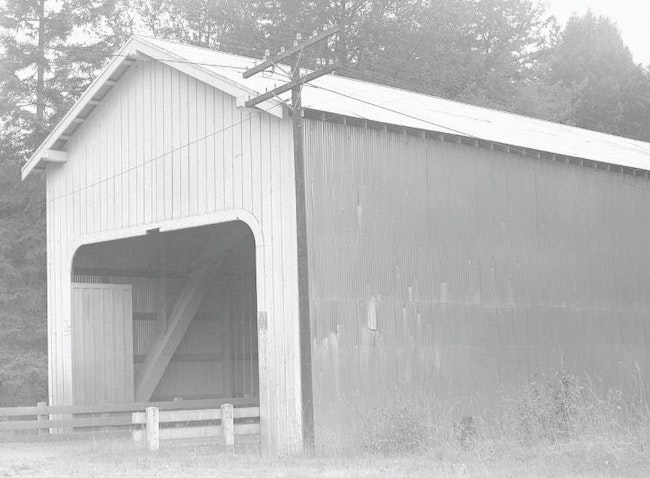 The Brumbaugh Covered Bridge, 1957.The photo is part of the Salem Public Library Collection. Ben Maxwell/Photo
The Brumbaugh Covered Bridge, 1957.The photo is part of the Salem Public Library Collection. Ben Maxwell/Photo
Editor’s note: Part I of a two-part series on covered bridges.
This is a tale of two, no, make that three, covered bridges, a birthday, and the retooling of a mill town. I pledged to cover the history of more Covered Bridges across Lane County in a previous column and this is the first entry.
Up this week is the Brumbaugh Covered Bridge, one of our historic bridges that lamentingly fell to progress in 1979.
Samuel Brumbaugh and his wife Lydia were early settlers in the Walden area, southeast of Cottage Grove. Mosby Creek was known earlier as the Brumbaugh River and besides the covered bridge, the Brumbaugh name lives on with the local cemetery nearby; part of the land for it was donated by Samuel and Lydia, who repose there.
The Brumbaugh Covered Bridge crossed Mosby Creek about six miles from downtown Grove. The concrete span that replaced it is just after where Blue Mountain School Road breaks off from Mosby Creek Road to follow the western bank, while Mosby Creek Road makes a big bend and follows the eastern bank.
According to Bill Cockrell’s book, “Oregon’s Covered Bridges” 2008, there were two Brumbaugh bridges (possibly three, some sources say) at this site. The first known version was built in 1925 for $3,800. It had massive 12” x 12” timbers as the chords and was housed using 1” x 12” lumber with battens. The clearance was 14’ 8” and a photo of this first Brumbaugh bridge shows boards of the end housings being broken out. Scanning the pictures in Cockrell’s book, many other covered bridges suffered missing boards due primarily to the fact trucks had grown larger since the days of the Model T.
The next Brumbaugh bridge replaced its predecessor in 1948. This 90-foot Howe truss bridge sat on wooden pilings in the river.
Boards attached to the piers in the direction of the river flow acted like cow catchers to steer floating debris away from the supports and downstream. Originally the bridge was constructed open and unhoused. That changed two years later when the two ends were housed in wood and the roof and sides were covered in sheet metal.
In 1948 when this bridge was first built, traffic on Mosby Creek Road wasn’t so heavy, neither were the log trucks. In 1978 Lane County engineers rated the bridge at 20,000-pounds capacity and at the time a loaded log truck clocked in at around double that. The bridge’s 30th birthday party was spoiled by the announcement that the Brumbaugh Bridge would be moving permanently.
Safety first
Al Driver, Lane County Public Works Director, recommended to the Lane County Board of Commissioners that the bridge be moved or put into storage and replaced with a concrete span. It was not possible to beef up the wooden structure to meet the weight requirements. The local paper quotes Driver’s assistant, Lealynn Jacobson, as saying, “We always try to preserve the covered bridges, but we also have a responsibility to the people of the community in keeping the roads workable.”
Even before this announcement, when the discussion of problems with traffic and the Brumbaugh Bridge filtered down to Cottage Grove, the local chamber and government, having become aware of the value of covered bridges as a tourist draw, were the first to object and recommend that the bridge stand and a bypass be constructed for the log traffic. This had little effect as all three plans suggested by Public Works involved the bridge being relocated. The commissioners agreed and the bridge was removed in September 1979.
After the truss was lifted off its piers, several possible sites were proposed to relocate it on roads with less traffic. Nearby Lancaster Road was suggested, as was Alton Baker Park in Eugene, as well as a request from the City of Cottage Grove to move it to the historic district.
Costs of relocation prevented any of the hopeful “rehoming” options for the bridge, and it ended up being stored at the County workyard at the Waste Transfer Station off Sears Road. But that is not the end of the Brumbaugh Bridge.
The next chapter
As mentioned earlier, the community of Cottage Grove had glommed on to the iconic covered bridges in the area as a much-needed new direction for the town. Loss of jobs in the timber trade in the late 1970s and early ’80s due to automation and harvest restrictions, had the town bleeding citizens. Local businesses were hurting and the general outlook was poor. The Chamber of Commerce and city government had grasped onto the idea of promoting the area as a tourist destination.
Jim Gilroy, mayor at the time, remembered that Alan Bair of Pacific Yurts showed up with a logo at a chamber meeting showing a Covered Bridge. (There were five at the time in the immediate area.)
The excitement of the idea moved Gilroy to state, “Let’s call ourselves ‘The Covered Bridge Capital of the World!’” Other chamber members, while they did like the idea, balked on claiming the “world” title, dialing it back to just Oregon. Decades later, then-Chamber director Travis Palmer changed the Oregon part so it’s now “The Covered Bridge Capital of the West,” an acknowledgement of the Chamber’s Railroad Covered Bridge, the only one remaining west of the Mississippi.
In I986 the World Fair was held in Vancouver, B.C., and Cottage Grove sent a delegation to make a presentation on July 5 at the Oregon State Pavilion there. Taking along a scale model of a Covered Bridge constructed by Russ McGuire, The Western Oregon Opry, The Grovetones and about 35 community members, Cottage Grove made a big splash while promoting its case for the Covered Bridge Capital claim. The exhibition put on by the delegation won the Oregon League of Cities Award of Excellence and many visitors’ heads were turned by the small town that hit it out of the park.
The next year, 1987, was a special one for Cottage Grove. With the original town settlement, feud, divorce, and remarriage there are a lot of dates to consider when it comes to the “founding of Cottage Grove.”
After studious research, it was agreed that Feb. 11, 1887 was the first recorded legal establishment of a city government in Cottage Grove. Planning for celebrating this milestone began at least two years before the actual anniversary, with a discussion at a City Council meeting.
A Centennial planning committee was established and its goal was to turn the festivities into a year-long celebration with many different parts. The full story of this celebration that took place 35 years ago will appear in future issues.
After embracing the Covered Bridge “Capital” moniker, interested parties in town briefly considered moving the Chamber’s Railroad Bridge into the downtown. That would be a very visible statement for the Covered Bridge Capital to make, but practicality reigned and those plans were dropped. But a seed had been planted.
Gilroy remembers that the idea of putting a covered bridge right next to City Hall would send a major message as to their importance as well as to help create an impressive western entrance to the historic downtown. “As an all-volunteer effort, the building of a bridge was a way to get the people of the community involved in our year long-celebration,” Gilroy said.
The old Main Street Bridge concrete abutments were still in place alongside the current modern bridge. Why not construct a covered bridge on those?
The idea gained steam and a number of levers were pulled in pursuit of a 3/8th-scale pedestrian model of the Chambers Bridge to be constructed on the old bridge site.
Remember the Brumbaugh bridge? It was still languishing in the county workyard. When Gilroy asked then-Chairman of the County Commissioners, Peter DeFazio, if the bridge could be used for the downtown planned footbridge, DeFazio told him to make a formal request to the board of commissioners. After consideration, the Lane Commissioners, in May 1986, not only gave Cottage Grove the Brumbaugh, but also another bridge it had in storage, the Meadows Covered Bridge, that had been located near Florence. Both bridges had been decommissioned and taken down in 1979.
Drawing up the plans
A volunteer bridge committee was formed with DeRoss Kinkade serving as its chairman. By adding concrete to the old bridge abutments for leveling, the group would have a location, a vision, and now materials; what was needed next were blueprints.
Then-Cottage Grove City Engineer Roger Sinclair stepped in to do the calculations and draw the designs for the proposed bridge, and by September 1986 the plans were ready. Sinclair left many marks on Cottage Grove; the 1965 version of the Swinging Bridge, City Hall, and many other projects around town, including the wastewater treatment plant.
There were a number of hurdles to building the bridge yet to cross, including funding, getting permits, recruiting the volunteer labor to build it, and time itself. It was hoped that the bridge would be ready for the grand kickoff for the start of the centennial celebration year, timed to coincide with the Feb. 11, 1987 anniversary date. That was announced in the paper and even a program printed listing the dedication of the new covered bridge and burying of a time capsule listed during the two-day opening celebration.
While many of the activities for the gala kick-off of the centennial year went off as planned, the pedestrian footbridge and time capsule would have to wait a bit longer in the celebration year.
Next week: A look forward to the birth of the Centennial Bridge, which became an established stop on the official Covered Bridge Tour, and one that gave new life to two old bridges; the Brumbaugh and the Meadows Covered Bridges. Link to read here
Email: [email protected]








